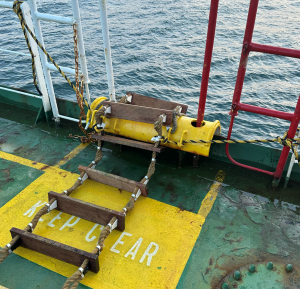CHIRP Maritime has shared an event, in which an inbound vessel embarked the pilot at sea. The vessel had a freeboard of 6m and had rigged a pilot ladder.
The pilot, upon reaching the deck of the vessel, discovered that the ladder had not been secured in accordance with the regulations and had been tied to the railings on either side of the pilot embarkation station and ‘secured’ to the ladder by a spliced eye wrapping around the side ropes.
It quickly became apparent that neither of these lashings had secured the ladder at all, and the ladder had been held by the fortunate accident that the ladder step had jammed against the securing points on the rounded fishplate.
Upon arriving on the bridge, the pilot discussed the issue with the master, who seemed disinterested in the near miss that had just occurred. The vessel was reported to the Designated Person Ashore (DPA) and Port State Control due to the non-compliant pilot ladder.
According to CHIRP, this arrangement is a classic example of poor training and leadership and a vessel that could be more compliant by design. Ideally, certified (≥48kN) lashing points should be positioned on the deck, more than 0.95m from the fishplate. This effectively prevents the pilot from accidentally grabbing hold of a loose section of lashing or ladder as they gain access to the deck. It allows the crew to secure effectively using a rolling hitch.
This vessel was eventually allowed to sail after providing a suitable securing arrangement and is likely to be removed from the list of approved vessels for the terminal operators. A costly mistake that thankfully didn’t cost the pilot his life.
CHIRP notes that some ports refuse to put a pilot onto a vessel until non-compliance has been rectified. However, greater sharing of pilot incident data is required. Many pilot jurisdictions have an app for collecting data, but this data is only sometimes shared with other pilotage authorities and only sometimes passed on to the next port. The best practice is to inform the next port so that they are forewarned.
Lessons learned
- Culture – The master appeared disinterested. Does your company respond only when an accident or incident occurs? Does your crew have the confidence to speak up when operations are not carried out safely? If a pilot is injured, or worse, because of non-compliance with securing a pilot ladder, how would you respond when asked, “Did you check that the ladder was appropriately secured?”
- Communication – Pilots are strongly encouraged to forward their findings to the next port so they can be forewarned. Repeat offenders should be reported to the Port State and Flag State.
- Capability – Management must check that the crews employed have the necessary safety skills to secure a pilot ladder in accordance with the regulations. When a new crew joins your vessel, do you check to see if they can all rig and secure a pilot ladder?
- Teamwork – Onboard management should encourage a teamwork culture so the crew have a shared approach to meeting safety compliance for all work. It improves the working environment and enhances wellbeing. Teamwork must also be demonstrated by senior management.
- Design – the vessel is not new, but someone has signed off on this arrangement: why?































































